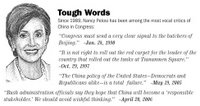Oil markets have been on a wild ride in recent weeks. After hitting a high of $77 last summer, oil prices have continued to fall and briefly dipped below $50 a barrel in intraday trading during the week of January 15
th. Today oil zoomed past $58.
Numerous articles have been written about reduced oil demand due to high prices, pegging last summer as the tipping point. Others have tried to figure who will be hurt and who will benefit from the decline in prices. It is somewhat ironic that in the middle of all this volatility, the viability of alternative sources of fuel such as ethanol has come under scrutiny. Lower oil prices in conjunction with rising corn prices make ethanol’s economics much less attractive. But ethanol is another topic for another day.
Analysts and experts appear to be ignoring a multitude of signals and data points which should allay any fears of a dooms day scenario. Of course, this means Mr. Market may be providing us with a few attractive opportunities in the energy sector.
 First, there is the share price performance of various publicly traded companies since the slide in oil prices began last summer. They have held up quite well and have even increased in some instances. For example, Exxon Mobil (NYSE: XOM) has appreciated about 20% in that time span. Indeed, even at these lower levels (see graphic from the Wall Street Journal to the left), Big Oil companies remain highly profitable cash machines. In fact these companies’ internal forecasts and capital budgets are predicated on much lower oil price assumptions than we are faced with today.
First, there is the share price performance of various publicly traded companies since the slide in oil prices began last summer. They have held up quite well and have even increased in some instances. For example, Exxon Mobil (NYSE: XOM) has appreciated about 20% in that time span. Indeed, even at these lower levels (see graphic from the Wall Street Journal to the left), Big Oil companies remain highly profitable cash machines. In fact these companies’ internal forecasts and capital budgets are predicated on much lower oil price assumptions than we are faced with today.
Second, there is the minor issue of supply and demand. Many opine that based on supply and demand economics alone, ignoring geopolitical factors, oil prices should be at $40. That may be accurate but good luck eliminating those risks altogether. If it was a forgone conclusion, President Bush would not have felt compelled to ask for a doubling of the U.S. Strategic Petroleum Reserves. Apart from this risk premium, the supply/demand imbalance is far from over. A recent guide provided by The Wall Street Journal titled “Unreliable Spigots, Mighty Thirsts” highlighted the precariousness of the world’s oil supply and the insatiable appetite for oil. The U.S. will remain the world’s largest consumer of oil and developing countries’ demand for oil will surpass that of industrialized nations in about two decades. Notwithstanding Peak Oil Theory, this oil will have to come from somewhere, putting a floor on prices.
Third, there is the flow of smart money into energy assets. General Electric (NYSE: GE) recently purchased oil services company Vetco Gray for $1.9 billion. Goldman Sachs (NYSE: GS) and Morgan Stanley (NYSE: MS) are teaming up to buy the oil and gas assets of Dominion Resources Inc. (NYSE:D) for $15 billion. And yes, there is Mr. Buffett’s $1 billion bet on ConocoPhillips (NYSE: COP). These investors should realize above average returns on their investments without requiring sky high oil prices. Indeed, current oil price levels would suffice. The U.S. Department of Energy’s forecast is for oil prices to dip to $47 a barrel in 2014, rising to $57 in 2030. Keep in mind these prices are well below oil’s 1980’s peak price on an inflation-adjusted basis.
Those three reasons have convinced my brother and I to build a position in ConocoPhillips over the last several months at an average price of $64. The stock trades at just 7 times 2007 earnings estimates. The knock against the stock is its heavy debt load compared to peers, its willingness to pay up for acquisitions and its exposure to such risky locales as Venezuela and Russia (ConocoPhillips has a 20% stake in Lukoil). Still, in the U.S., ConocoPhillips is the third largest oil company, the second largest refiner and the largest natural gas producer. Not bad and you get diversification to boot. We also recently took a position in Diamond Offshore (NYSE: DO) at just below $81. Diamond trades at around 9 times 2007 earnings estimates. The stock has declined as Mr. Market seems to be pricing in an inevitable decline in oil prices which would diminish demand for Diamond’s rigs. But the need to replenish reserves won’t go away anytime soon and Diamond has plenty of rigs to oblige. Diamond sweetened the pot today by announcing a $4 special dividend on top of its regular dividend for shareholders of record on February 14th. At today’s stock price, if you hold the stock for a year, you can lock in about a 5% yield on your investment and the rest, as they say, is gravy.







